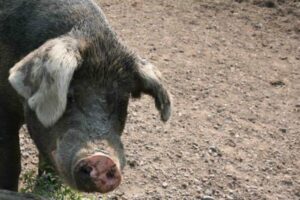Supermarkets To Offer ‘Humane’ Meat Products

Responding to a growing concern over ethical animal treatment, retailers Whole Foods, Safeway and Supervalu are moving to more clearly define “humane treatment” in the animal products they sell.
In collaboration with Global Animal Partnership, Whole Foods — known for their organic, fair trade and environmentally friendly product selections — has begun to unveil a rating system that ranks products according to their animal welfare standards on a scale from 1 – 5 indicating treatment of animals, to feed and slaughter methods.
Pork, beef and chicken products qualify if producers agree to volunteer information such as an animal spending its entire life in pasture settings, which receives the highest rank of 5, versus an animal only spending two-thirds of his or her life in pastures or rangelands, which would receive the lowest ranking of 1.
Chickens, who often live in the worst factory farm conditions, would be graded on farmers who maintain a lower numbers of birds, offer perches and enrichment activity including whole grains and hay.
In author Michael Pollan’s lucid article, “Power Steer” (NY Times 3/21/02)he traces the life of a cow through the farm system — a rarity in our anonymously homogenized culture of identical nuggets and burgers. It’s a helpful tool in tracking contamination and in verifying the care of animals. And the less an animal is stressed, the better the meat can taste, according to experts. The rating program requires traceability from its 700 farmers on all animal products.
Though there is no government-regulated standard for humane animal treatment, it may be a closer reality than we think. Common law regards pets as chattel — replaceable property — but as a Maryland couple is arguing in the case of police shooting their dog, animals are emotional beings and certainly irreplaceable family members — not tractors or furniture. How this affects and differentiates which animals we deem as siblings and children from those we call dinner is indeed a fine — and for many — an invisible line. There are, after all, cultures that keep chickens as pets and eat dogs.
The Global Animal Partnership is providing consumers an opportunity to make more intelligent decisions about their food, but it will come at a cost. Speculators say it could double the price of meats. But with conventional meat industries subsidized and disingenuously low-priced to begin with, if the program is in high demand, it could lead to standardized regulations, which would align prices.
Stay in touch with Jill on Twitter: www.twitter.com/jillettinger
Photo: Jill Ettinger

